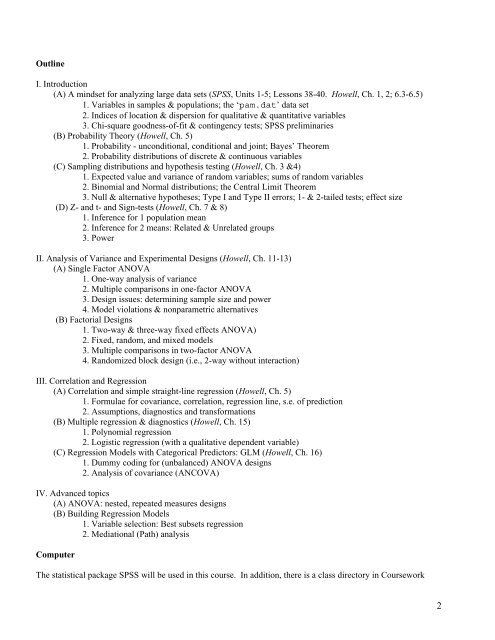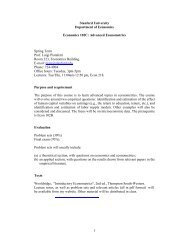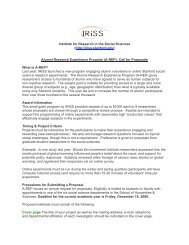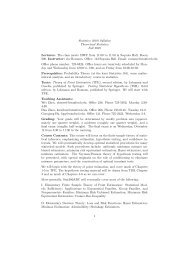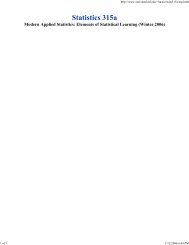Statistical Methods for Behavioral and Social Sciences
Statistical Methods for Behavioral and Social Sciences
Statistical Methods for Behavioral and Social Sciences
You also want an ePaper? Increase the reach of your titles
YUMPU automatically turns print PDFs into web optimized ePapers that Google loves.
Outline<br />
I. Introduction<br />
(A) A mindset <strong>for</strong> analyzing large data sets (SPSS, Units 1-5; Lessons 38-40. Howell, Ch. 1, 2; 6.3-6.5)<br />
1. Variables in samples & populations; the ‘pam.dat’ data set<br />
2. Indices of location & dispersion <strong>for</strong> qualitative & quantitative variables<br />
3. Chi-square goodness-of-fit & contingency tests; SPSS preliminaries<br />
(B) Probability Theory (Howell, Ch. 5)<br />
1. Probability - unconditional, conditional <strong>and</strong> joint; Bayes’ Theorem<br />
2. Probability distributions of discrete & continuous variables<br />
(C) Sampling distributions <strong>and</strong> hypothesis testing (Howell, Ch. 3 &4)<br />
1. Expected value <strong>and</strong> variance of r<strong>and</strong>om variables; sums of r<strong>and</strong>om variables<br />
2. Binomial <strong>and</strong> Normal distributions; the Central Limit Theorem<br />
3. Null & alternative hypotheses; Type I <strong>and</strong> Type II errors; 1- & 2-tailed tests; effect size<br />
(D) Z- <strong>and</strong> t- <strong>and</strong> Sign-tests (Howell, Ch. 7 & 8)<br />
1. Inference <strong>for</strong> 1 population mean<br />
2. Inference <strong>for</strong> 2 means: Related & Unrelated groups<br />
3. Power<br />
II. Analysis of Variance <strong>and</strong> Experimental Designs (Howell, Ch. 11-13)<br />
(A) Single Factor ANOVA<br />
1. One-way analysis of variance<br />
2. Multiple comparisons in one-factor ANOVA<br />
3. Design issues: determining sample size <strong>and</strong> power<br />
4. Model violations & nonparametric alternatives<br />
(B) Factorial Designs<br />
1. Two-way & three-way fixed effects ANOVA)<br />
2. Fixed, r<strong>and</strong>om, <strong>and</strong> mixed models<br />
3. Multiple comparisons in two-factor ANOVA<br />
4. R<strong>and</strong>omized block design (i.e., 2-way without interaction)<br />
III. Correlation <strong>and</strong> Regression<br />
(A) Correlation <strong>and</strong> simple straight-line regression (Howell, Ch. 5)<br />
1. Formulae <strong>for</strong> covariance, correlation, regression line, s.e. of prediction<br />
2. Assumptions, diagnostics <strong>and</strong> trans<strong>for</strong>mations<br />
(B) Multiple regression & diagnostics (Howell, Ch. 15)<br />
1. Polynomial regression<br />
2. Logistic regression (with a qualitative dependent variable)<br />
(C) Regression Models with Categorical Predictors: GLM (Howell, Ch. 16)<br />
1. Dummy coding <strong>for</strong> (unbalanced) ANOVA designs<br />
2. Analysis of covariance (ANCOVA)<br />
IV. Advanced topics<br />
(A) ANOVA: nested, repeated measures designs<br />
(B) Building Regression Models<br />
1. Variable selection: Best subsets regression<br />
2. Mediational (Path) analysis<br />
Computer<br />
The statistical package SPSS will be used in this course. In addition, there is a class directory in Coursework<br />
2


